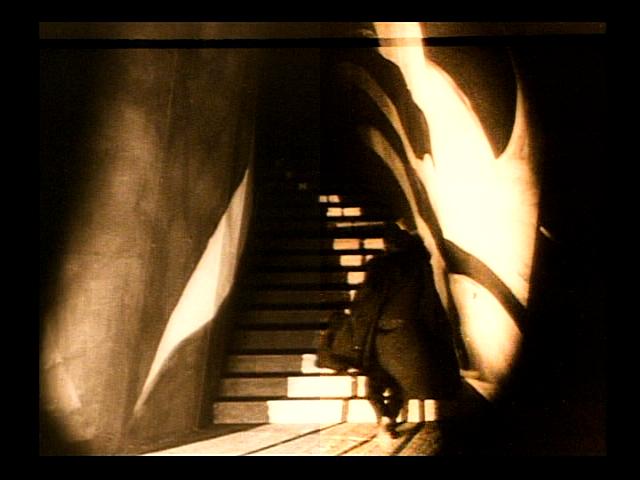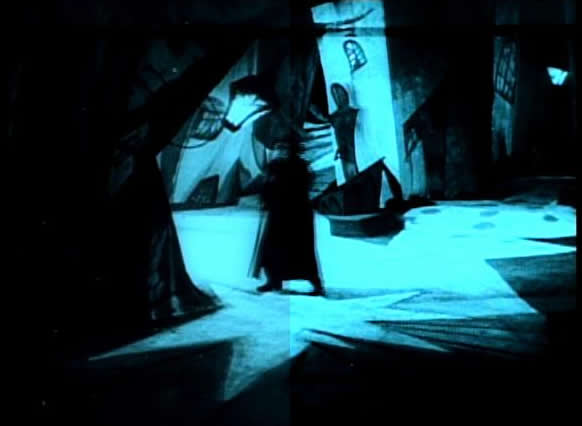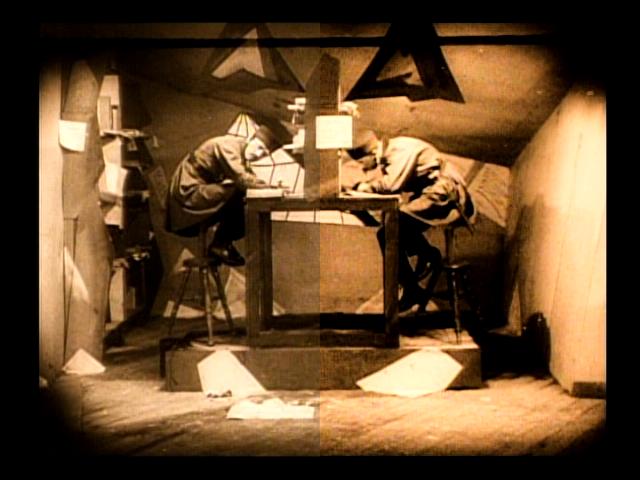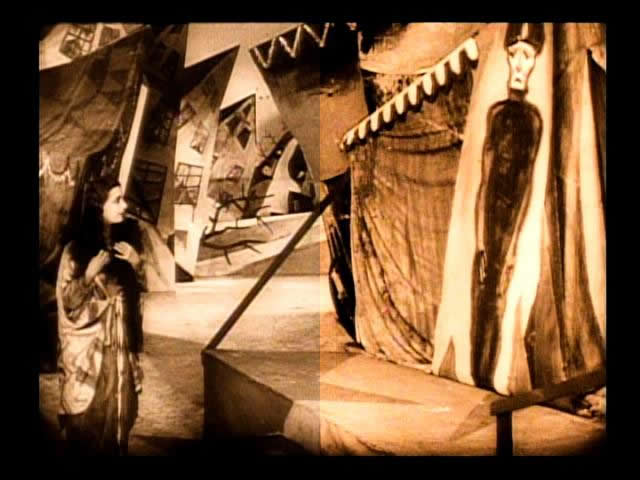FEAR AND DYSTOPIA IN ALTERNATE REALITIES:
The Cabinet of Dr. Caligari ▪ Sin City ▪ Un Chien Andalou
“In no way are film sets architecture! … The film, the art of ‘optical’ illusion, needs utopia. It needs a set that is utopian space, simulating the atmosphere of a space for the imagination.”
– set designer Walter Reimann, 1929
 The sets for The Cabinet of Dr. Caligari (Wiene 1920) were never meant to look like reality. They are entirely artificial, loosely based on traditional architectural forms suggesting a small German town but making no specific references. Reimann, quoted above, made it clear that the artistic intent of the film was not to imitate architecture but to disconnect the film from reality, creating a subjective world in which the action of the film could believably take place.
The sets for The Cabinet of Dr. Caligari (Wiene 1920) were never meant to look like reality. They are entirely artificial, loosely based on traditional architectural forms suggesting a small German town but making no specific references. Reimann, quoted above, made it clear that the artistic intent of the film was not to imitate architecture but to disconnect the film from reality, creating a subjective world in which the action of the film could believably take place.
 Although a product of very different time periods, Sin City (Miller 2005) likewise represents a world fabricated specifically for the action which takes place there. Based on the comic book series, the film recreates the look of the comic as faithfully as possible. The urban environments of both films are highly stylized and exaggerated, designed to create a unique setting for the action of the film.
Although a product of very different time periods, Sin City (Miller 2005) likewise represents a world fabricated specifically for the action which takes place there. Based on the comic book series, the film recreates the look of the comic as faithfully as possible. The urban environments of both films are highly stylized and exaggerated, designed to create a unique setting for the action of the film.
The sets of The Cabinet of Dr. Caligari create a very clear, if basic, relationship between strange events and strange places. Caligari uses dark, jagged forms to render what could be a traditional urban space unfamiliar, creating a portentous feeling of uneasiness. The urban environment is essential to the creation of the mysterious dystopia in which the plot operates. The film is considered a masterful example of German Expressionism (Thom 2007) and, true to the tenets of this movement (Wikipedia 2006b), the environment of the film is distorted for emotional effect and designed to convey the particular psychic state of Francis, who tells the story. Buildings and trees are twisted into sharp points, suggesting danger, but also hinting at the distortions of the plot. Walls slant inwards, creating an uncomfortable sense of claustrophobia and contorting the actions of the characters.
(Thom 2007) and, true to the tenets of this movement (Wikipedia 2006b), the environment of the film is distorted for emotional effect and designed to convey the particular psychic state of Francis, who tells the story. Buildings and trees are twisted into sharp points, suggesting danger, but also hinting at the distortions of the plot. Walls slant inwards, creating an uncomfortable sense of claustrophobia and contorting the actions of the characters.
 “Using Expressionistic themes the connection with reality is both non-existent, in parallel with the unhinged mind of either Francis or Caligari, and incredibly unsettling. The inhabitants of this skewed world, especially the ghost-like Cesare, fit right in, twisting themselves terribly (both internally and externally) to accommodate their surroundings.”
“Using Expressionistic themes the connection with reality is both non-existent, in parallel with the unhinged mind of either Francis or Caligari, and incredibly unsettling. The inhabitants of this skewed world, especially the ghost-like Cesare, fit right in, twisting themselves terribly (both internally and externally) to accommodate their surroundings.”
– film critic Damian Cannon, 1997
 The sets of Caligari were painted to distort perspective and unbalance the action (Lähn 1999). The urban space presented is an unreal realm, a deliberately artificial environment where terrible things are possible, even probable: the sets themselves conjure nightmares and horrific hallucinations. Significantly, the only one of thirty-three sets which portrays normal architecture – rectilinear, orderly, and visually quite benign - is the courtyard of the insane asylum. This architectural hint provides the only indication of the ultimate resolution of the plot: Francis is mad, the story and its nightmarish environment merely the product of his delusions. The film was criticized in Germany for this portrayal of Expressionism as the product of a deranged mind (Lähn 1999). Nonetheless, The Cabinet of Dr. Caligari makes highly effective use of the urban environment to create fear and dystopia, using techniques that would be imitated – if with more subtlety – in many future films.
The sets of Caligari were painted to distort perspective and unbalance the action (Lähn 1999). The urban space presented is an unreal realm, a deliberately artificial environment where terrible things are possible, even probable: the sets themselves conjure nightmares and horrific hallucinations. Significantly, the only one of thirty-three sets which portrays normal architecture – rectilinear, orderly, and visually quite benign - is the courtyard of the insane asylum. This architectural hint provides the only indication of the ultimate resolution of the plot: Francis is mad, the story and its nightmarish environment merely the product of his delusions. The film was criticized in Germany for this portrayal of Expressionism as the product of a deranged mind (Lähn 1999). Nonetheless, The Cabinet of Dr. Caligari makes highly effective use of the urban environment to create fear and dystopia, using techniques that would be imitated – if with more subtlety – in many future films.
 In Sin City, the urban environment is not distorted physically but is manipulated in post-production to make the scenes look like comic-book illustrations, not like reality (Making of Sin City, Miller 2005). The setting is fictional Basin City, more traditional in form than the twisted environment of Caligari, but where deformations of character - corruption, revenge, murder, lust and general violence - are accepted as normal (Wikipedia, 2006c).
In Sin City, the urban environment is not distorted physically but is manipulated in post-production to make the scenes look like comic-book illustrations, not like reality (Making of Sin City, Miller 2005). The setting is fictional Basin City, more traditional in form than the twisted environment of Caligari, but where deformations of character - corruption, revenge, murder, lust and general violence - are accepted as normal (Wikipedia, 2006c).  Sin City uses green-screen technology and digital effects rather than painted sets, but the visual genre produced is very similar to that of Caligari: an intentionally artificial town, dark and ominous with exaggerated forms (markedly deformed in Caligari, more subtly elongated in Sin City), deep shadows punctuated by slashes (graffiti in Caligari, face bandages and scars in Sin City),
Sin City uses green-screen technology and digital effects rather than painted sets, but the visual genre produced is very similar to that of Caligari: an intentionally artificial town, dark and ominous with exaggerated forms (markedly deformed in Caligari, more subtly elongated in Sin City), deep shadows punctuated by slashes (graffiti in Caligari, face bandages and scars in Sin City),  primarily black and white with colour only for specific effects (night versus day in Caligari, more sophisticated use in Sin City where colour is applied for selective emphasis). By portraying a world deliberately unlike anything seen in reality, both films create an unreal realm where the strangeness of their story becomes more credible.
primarily black and white with colour only for specific effects (night versus day in Caligari, more sophisticated use in Sin City where colour is applied for selective emphasis). By portraying a world deliberately unlike anything seen in reality, both films create an unreal realm where the strangeness of their story becomes more credible.
The Surrealist masterpiece Un Chien Andalou (Buñuel 1929) presents the inverse of this technique. Andalou is primarily set in an urban apartment, presumably within a city, but that city is never seen: views of the street focus on vehicles and people, never presenting the character of the urban space. The city in Andalou is simply not part of the plot – arguably, there is no plot – as the action of the film is not intended to be believed. This film was designed as a surreal experience, a series of hallucinatory non-sequiturs: the action is designed for shock value, never intended to be credible. The environment is convincing because it looks completely ordinary, which serves to articulate the distinction between the real setting of the film and the surreal action which occurs there. Thus the technique and effect are directly opposite those used in The Cabinet of Dr. Caligari and Sin City: those films operate in alternate physical realities to make their strangeness of their stories more believable, while Andalou operates in a completely ordinary physical reality to make the strangeness of the story impossible to believe.
PREVIOUS PAGE ▪ NEXT PAGE














